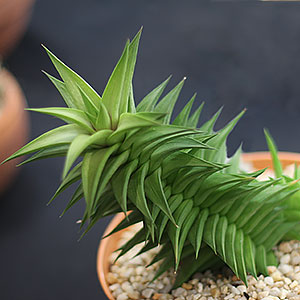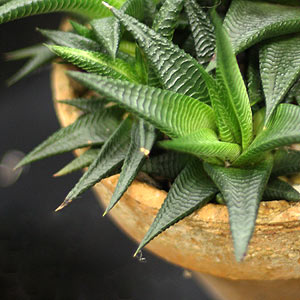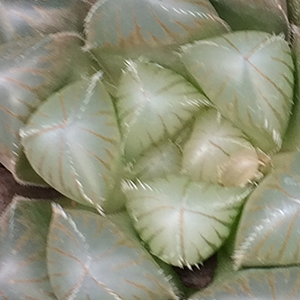
With attractive foliage year round, Haworthia species provide a great deal of variety in small growing succulents. With fleshy foliage, often patterned with brown or white spots they make excellent container plants.
Many species have translucent leaves and these are commonly called the Window Plant or Crystal plant.
Most species are in active growth from fall through to spring, in summer when they are dormant the plants need a rest from watering. Related to Aloes, they have the same fleshy leaves. They look great in a container as a single specimen plant where they can show off their natural shape.
They can also be left to form a mass clump if desired. They vary in form from low growing types to those with elongated rosettes that can reach 10 – 20 cm in height such as Haworthia viscosa (pictured right).

From South Africa, they grow over a wide area and diversity is large, over 70 named species. Even individual species come in a number of varieties with the popular Haworthia attenuata being available in at least 10 varieties.
The color of the foliage will depend on the amount and intensity of the sun.
Care
They key to successfully growing Haworthia is good drainage and proper light. Pictured right we have Haworthia nigra, a rarely offered species, growing well in a well drained medium in a container.
In the natural environment they will grow best when they receive protection from the hot afternoon sun, often in rocky areas beneath other plants, growing in dappled shade, or amongst rocks, usually on the side where they receive morning sun and afternoon shade.

The rocky area also provide the drainage that is so essential.
The protection from sun may not be required when grown in cooler climates, or grown indoors.
How to Grow Haworthia
Best grown in a container in a very open free draining succulent soil. Frost protection is essential and the amount of sun will depend on intensity.
- Full sun to part shade.
- Free draining soil.
- Hold back on water during dormancy.
- Only water once the container has dried out, never let the pot sit in water
Like all groups of plants, some are seen as more desirable than others, and with Haworthia this is no different. Some of the better known species include.
- Haworthis copperi
- Haworthia limifolia
- Haworthia magnifica var. splendens
- Haworthia attenuata
- Haworthia reinwardtii
- Haworthia maughanii
- Haworthia obtusa
Haworthia Propagation
The species can be propagated from seed.
You can also propagate by division of larger clumps. Best done when they are in active growth rather than in dormancy.
You may also be interested in
Haworthia are available for sale from the following specialist nurseries.
KARA CACTUS & SUCCULENT NURSERY
Small, Pacific Northwest retail mail order specialty nursery. Our goal is to provide to the public quality, well-grown succulent plants at a reasonable and fair price. We also specialize in rare seed-grown Haworthias, a good selection of Echeverias, Lithops and cacti.
www.KaraCactus.com

